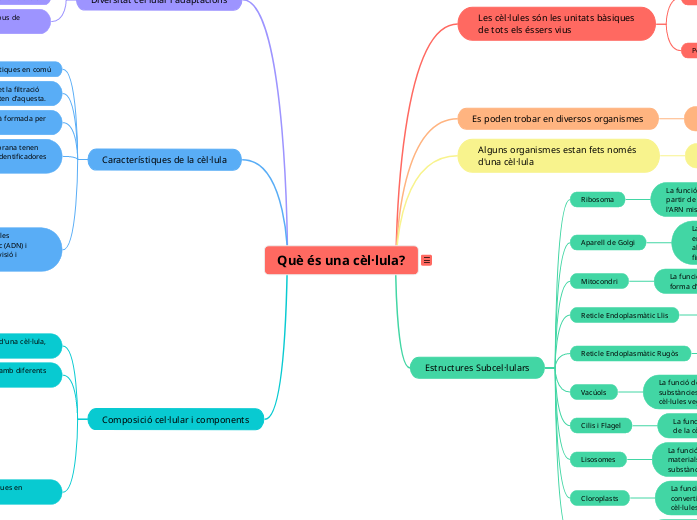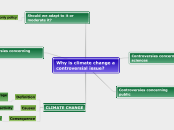Què és una cèl·lula?
What is a cell?
Trees in a forest, fish in a river, horseflies on a farm, lemurs in the jungle, reeds in a pond, worms in the soil -- all these plants and animals are made of the building blocks we call cells. Like these examples, many living things consist of vast numbers of cells working in concert with one another. Other forms of life, however, are made of only a single cell, such as the many species of bacteria and protozoa. Cells, whether living on their own or as part of a multicellular organism, are usually too small to be seen without a light microscope.
Cells share many common features, yet they can look wildly different. In fact, cells have adapted over billions of years to a wide array of environments and functional roles. Nerve cells, for example, have long, thin extensions that can reach for meters and serve to transmit signals rapidly. Closely fitting, brick-shaped plant cells have a rigid outer layer that helps provide the structural support that trees and other plants require. Long, tapered muscle cells have an intrinsic stretchiness that allows them to change length within contracting and relaxing biceps.
Still, as different as these cells are, they all rely on the same basic strategies to keep the outside out, allow necessary substances in and permit others to leave, maintain their health, and replicate themselves. In fact, these traits are precisely what make a cell a cell.
What Defines a Cell?
Cells are considered the basic units of life in part because they come in discrete and easily recognizable packages. That's because all cells are surrounded by a structure called the cell membrane -- which, much like the walls of a house, serves as a clear boundary between the cell's internal and external environments. The cell membrane is sometimes also referred to as the plasma membrane.
Cell membranes are based on a framework of fat-based molecules called phospholipids, which physically prevent water-loving, or hydrophilic, substances from entering or escaping the cell. These membranes are also studded with proteins that serve various functions. Some of these proteins act as gatekeepers, determining what substances can and cannot cross the membrane. Others function as markers, identifying the cell as part of the same organism or as foreign. Still others work like fasteners, binding cells together so they can function as a unit. Yet other membrane proteins serve as communicators, sending and receiving signals from neighboring cells and the environment -- whether friendly or alarming (Figure 1).
Within this membrane, a cell's interior environment is water based. Called cytoplasm, this liquid environment is packed full of cellular machinery and structural elements. In fact, the concentrations of proteins inside a cell far outnumber those on the outside -- whether the outside is ocean water (as in the case of a single-celled alga) or blood serum (as in the case of a red blood cell). Although cell membranes form natural barriers in watery environments, a cell must nonetheless expend quite a bit of energy to maintain the high concentrations of intracellular constituents necessary for its survival. Indeed, cells may use as much as 30 percent of their energy just to maintain the composition of their cytoplasm.
What Other Components Do Cells Have?
As previously mentioned, a cell's cytoplasm is home to numerous functional and structural elements. These elements exist in the form of molecules and organelles -- picture them as the tools, appliances, and inner rooms of the cell. Major classes of intracellular organic molecules include nucleic acids, proteins, carbohydrates, and lipids, all of which are essential to the cell's functions.
Nucleic acids are the molecules that contain and help express a cell's genetic code. There are two major classes of nucleic acids: deoxyribonucleic acid (DNA) and ribonucleic acid (RNA). DNA is the molecule that contains all of the information required to build and maintain the cell; RNA has several roles associated with expression of the information stored in DNA. Of course, nucleic acids alone aren't responsible for the preservation and expression of genetic material: Cells also use proteins to help replicate the genome and accomplish the profound structural changes that underlie cell division.
Proteins are a second type of intracellular organic molecule. These substances are made from chains of smaller molecules called amino acids, and they serve a variety of functions in the cell, both catalytic and structural. For example, proteins called enzymes convert cellular molecules (whether proteins, carbohydrates, lipids, or nucleic acids) into other forms that might help a cell meet its energy needs, build support structures, or pump out wastes.
Carbohydrates, the starches and sugars in cells, are another important type of organic molecule. Simple carbohydrates are used for the cell's immediate energy demands, whereas complex carbohydrates serve as intracellular energy stores. Complex carbohydrates are also found on a cell's surface, where they play a crucial role in cell recognition.
Finally, lipids or fat molecules are components of cell membranes -- both the plasma membrane and various intracellular membranes. They are also involved in energy storage, as well as relaying signals within cells and from the bloodstream to a cell's interior (Figure 2).
Some cells also feature orderly arrangements of molecules called organelles. Similar to the rooms in a house, these structures are partitioned off from the rest of a cell's interior by their own intracellular membrane. Organelles contain highly technical equipment required for specific jobs within the cell. One example is the mitochondrion -- commonly known as the cell's "power plant" -- which is the organelle that holds and maintains the machinery involved in energy-producing chemical reactions
What Are the Different Categories of Cells?
Rather than grouping cells by their size or shape, scientists typically categorize them by how their genetic material is packaged. If the DNA within a cell is not separated from the cytoplasm, then that cell is a prokaryote. All known prokaryotes, such as bacteria and archaea, are single cells. In contrast, if the DNA is partitioned off in its own membrane-bound room called the nucleus, then that cell is a eukaryote. Some eukaryotes, like amoebae, are free-living, single-celled entities. Other eukaryotic cells are part of multicellular organisms. For instance, all plants and animals are made of eukaryotic cells -- sometimes even trillions of them (Figure 4).
How Did Cells Originate?
Researchers hypothesize that all organisms on Earth today originated from a single cell that existed some 3.5 to 3.8 billion years ago. This original cell was likely little more than a sac of small organic molecules and RNA-like material that had both informational and catalytic functions. Over time, the more stable DNA molecule evolved to take over the information storage function, whereas proteins, with a greater variety of structures than nucleic acids, took over the catalytic functions.
As described in the previous section, the absence or presence of a nucleus -- and indeed, of all membrane-bound organelles -- is important enough to be a defining feature by which cells are categorized as either prokaryotes or eukaryotes. Scientists believe that the appearance of self-contained nuclei and other organelles represents a major advance in the evolution of cells. But where did these structures come from? More than one billion years ago, some cells "ate" by engulfing objects that floated in the liquid environment in which they existed. Then, according to some theories of cellular evolution, one of the early eukaryotic cells engulfed a prokaryote, and together the two cells formed a symbiotic relationship. In particular, the engulfed cell began to function as an organelle within the larger eukaryotic cell that consumed it. Both chloroplasts and mitochondria, which exist in modern eukaryotic cells and still retain their own genomes, are thought to have arisen in this manner (Figure 5).
Of course, prokaryotic cells have continued to evolve as well. Different species of bacteria and archaea have adapted to specific environments, and these prokaryotes not only survive but thrive without having their genetic material in its own compartment. For example, certain bacterial species that live in thermal vents along the ocean floor can withstand higher temperatures than any other organisms on Earth.
Conclusion
Cells are the smallest common denominator of life. Some cells are organisms unto themselves; others are part of multicellular organisms. All cells are made from the same major classes of organic molecules: nucleic acids, proteins, carbohydrates, and lipids. In addition, cells can be placed in two major categories as a result of ancient evolutionary events: prokaryotes, with their cytoplasmic genomes, and eukaryotes, with their nuclear-encased genomes and other membrane-bound organelles. Though they are small, cells have evolved into a vast variety of shapes and sizes. Together they form tissues that themselves form organs, and eventually entire organisms.
Composició cel·lular i components
Tipus principals de molècules orgàniques en cèl·lules
Lípids
Els lípids tenen funció d'acumular energia
i de transmetre senyals.
Glúcids
Els glúcids complexes serveixen com a font
d'energia de reserva
Els glúcids simples serveixen com a font
d'energia immediata
Proteïnes
Els enzims sintetitzen molècules
en altres de més útils .
Tenen diverses funcions com catalitzar
o formar part de l'estructura.
Formades per aminoàcids
Àcids nucleics
Àcids nucleics (DNA i RNA) contenen informació
genètica necessària per la divisió cel·lular
Conté diferents orgànuls amb diferents
composicions i funcions
El citoplasma és l'ambient interior d'una cèl·lula,
tots els orgànuls es troben aquí.
Característiques de la cèl·lula
El nucli és l'orgànul central de les cèl·lules eucariotes que conté el material genètic (ADN) i regula les funcions cel·lulars, com la divisió i l'expressió genètica.
Els porus nuclears són obertures a la membrana nuclear que permeten l'intercanvi de materials amb el citoplasma.
La cromatina és el conjunt de l'ADN i proteïnes que es condensa per formar cromosomes durant la divisió cel·lular.
El nuclèol és la estructura dins del nucli on es produeixen els ribosomes.
La membrana nuclear és una doble capa que envolta el nucli i regula l'entrada i sortida de substàncies.
Les proteïnes a la membrana tenen
funcions variades com identificadores
o comunicadores
La membrana de la cèl·lula està formada per
fosfolípids
Tenen una membrana que permet la filtració
de components que entren o surten d'aquesta.
Les cèl·lules tenen característiques en comú
Diversitat cel·lular i adaptacions
Es poden trobar exemples de diferents tipus de cèl·lules amb característiques úniques
Adaptades a diferents entorns i rols funcionals
Les cèl·lules poden semblar diferents entre si
Estructures Subcel·lulars
Centríols
La funció dels centríols és participar en la divisió cel·lular, ajudant a organitzar els microtúbuls durant la formació del fus mitòtic.
Cloroplasts
La funció dels cloroplasts és realitzar la fotosíntesi, convertint l'energia solar en energia química a les cèl·lules vegetals.
Lisosomes
La funció dels lisosomes és digerir i descompondre materials no desitjats, com residus cel·lulars o substàncies estranyes.
Cilis i Flagel
La funció dels cilis i flagels és facilitar el moviment de la cèl·lula o moure substàncies al seu voltant.
Vacúols
La funció dels vacúols és emmagatzemar substàncies com aigua, nutrients i residus, i en les cèl·lules vegetals, mantenir la pressió interna
Reticle Endoplasmàtic Rugòs
La funció del reticle endoplasmàtic rugós és la síntesi i el plegament de proteïnes, gràcies als ribosomes adherits a la seva superfície.
Reticle Endoplasmàtic Llis
La funció del reticle endoplasmàtic llis és la síntesi de lípids, el metabolisme de glúcids i la desintoxicació de substàncies tòxiques a la cèl·lula.
Mitocondri
La funció del mitocondri és produir energia en forma d'ATP mitjançant la respiració cel·lular.
Aparell de Golgi
La funció de l'aparell de Golgi és modificar, empaquetar i distribuir proteïnes i lípids produïts al reticle endoplasmàtic per a la seva destinació final dins o fora de la cèl·lula.
Ribosoma
La funció del ribosoma és sintetitzar proteïnes a partir de la informació genètica proporcionada per l'ARN missatger (ARNm).
Alguns organismes estan fets només
d'una cèl·lula
mentre que altres estan fets
per un conjunt de cèl·lules
Es poden trobar en diversos organismes
com plantes o animals però també
a fongs, algues,etc.
Les cèl·lules són les unitats bàsiques
de tots els éssers vius
Poden ser procariotes
Principalment organismes unicel·lulars
com: bacteris i arqueobacteris.
Generalment més petites
Més simples, sense orgànuls membranosos.
No tenen nucli; l'ADN està dispers en el citoplasma.
Poden ser eucariotes
Inclou organismes unicel·lulars i multicel·lulars
com: animals, plantes, fongs,etc.
Generalment més grans.
Més complexes, amb orgànuls membranosos.
Tenen nucli definit on es troba l'ADN.









